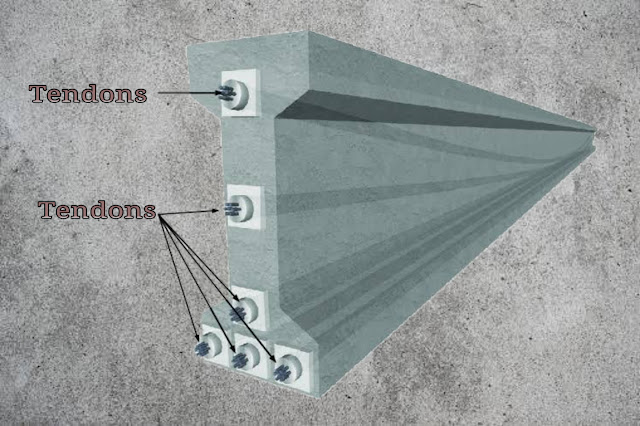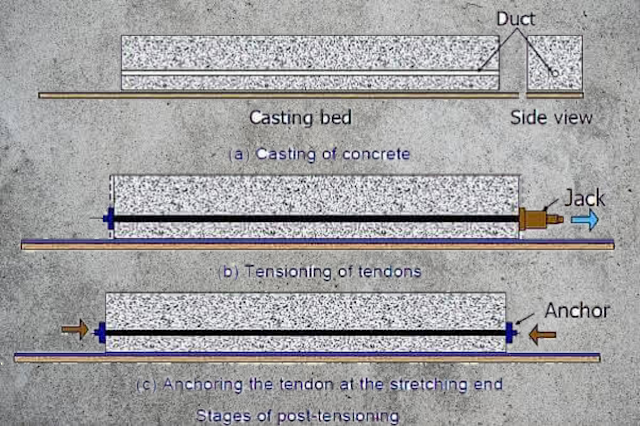PRESTRESSED CONCRETE
INTRODUCTION
Hardened concrete as the artificial hard rock that
could be designed or made with certain desired shape from casted fresh
concrete, has some weaknesses that make it alone unfit for major structures
which are the following
- · Have
little or negligible strength against tension
- · Brittle
property (not ductile), which makes it susceptible to cracking on loading
When we design different major structures, there are
two important criteria that are put into consideration
- Safety of the structure against failure, the structure should be able to carry desired loads for intended period of time.
- Serviceability or functional of the structure, where by the structure should neither deflect in extent that it affects comfort ability of users nor lead to detaching or breaking of attached materials such as tiles of curtain walls.
Introduction of reinforcements which are ductile or
elastic material into concrete, produce reliable composite material against
cracks formation and deflection.
In order to avoid excessive deflection on major
structures such as bridges, longer spanning beams prestressed concrete were introduced in construction industry.
What is prestressed concrete?
This is a concrete in which internal stress of
suitable magnitude and distribution are introduced so that the stresses
resulting from external load are counteracted to a desired degree.
Mechanism of prestressing
In this kind of concrete, steel embedded in concrete
is stretched or tensioned to certain point not exceeding steel yield point, since
it is stretched before yield point (steel with elastic property) will try to
regain its original shape.
As high tensile steel try to regain its original
shape, it compresses concrete in which it is embedded, so concrete is
precompressed before an application of loading desired for the structure.
Ways of prestressing concrete
Pre tensioning,
in this method of prestressing tendons are tensioned before the concrete is
casted or poured, this methods mostly is done at factories which produce
precast units such as slabs, lintels, and beams.
High tensile strength wire strands, or bundles are set or fixed inside concrete moulds, these strands are stretched or tensioned by using hydraulic jack to a certain point not exceeding yield point of tendons.
These
steel strands after being tensioned are anchored tightly against a rigid frame at
the head and foot of the setting bed or mould, fresh concrete is poured into
the bed or mould in direct contact with the strands or tendons. As the concrete
sets, the strands become bonded to the concrete.
Post
tensioning, .in
this method of prestressing tendons or strands are embedded and tensioned after
concrete has casted and hardened, this process most of time is done in situ on
ready produced precast units.
The concrete is casted around ducts or
sheathing in which tendons will be housed, after concrete has been set and cured properly over time, the tendons are inserted in ducts and stretched by
hydraulic jack either on one end or both ends.
After tensioning of tendons grout is
filled into tendon ducts to assist stress distribution between concrete and
tendons, also it prevents corrosion that could be caused by entrapped moisture.
Two concept in prestressed concrete
1. Prestressing
to transform concrete into an elastic material
This is the first and most common concept among engineers;
concrete material is seen to be converted from brittle material to elastic
(ductile) material by precompression given to it from tensioned tendons.
This concrete with elastic property is not susceptible
to cracking and deflection, as it is believed that no tensile stresses are
induced into concrete.
In this point of view concrete is subjected to
external and internal forces, where by external force is resulting from tensile
force tensioning the tendons and internal force as compression force resulting
as tendons try to regain its shape.
2. Prestressing
for combination of High strength steel with concrete
Here the prestressed concrete is seen as the
combination of concrete and reinforcement, similar to reinforced concrete where
by reinforcement takes tensile stress while concrete take compression stresses,
this behavior also is exist in prestressed concrete.
In prestressed concrete, high tensile steel are
tensioned by higher tension to certain strain so steel take all tensile
stresses, as high tensile steels tend to regain their shapes compress concrete,
so concrete withstand compression stresses form steel.
Conclusion
Prestressed concrete is the strong concrete composite
that is used in major projects in construction industry such as bridges, high
raised buildings, this is due to the use
of high strength steel tendons and full
utilization of concrete compressive strength also prestressed concrete has
lower or negligible deflection when compared to reinforced concrete.






Comments
Post a Comment